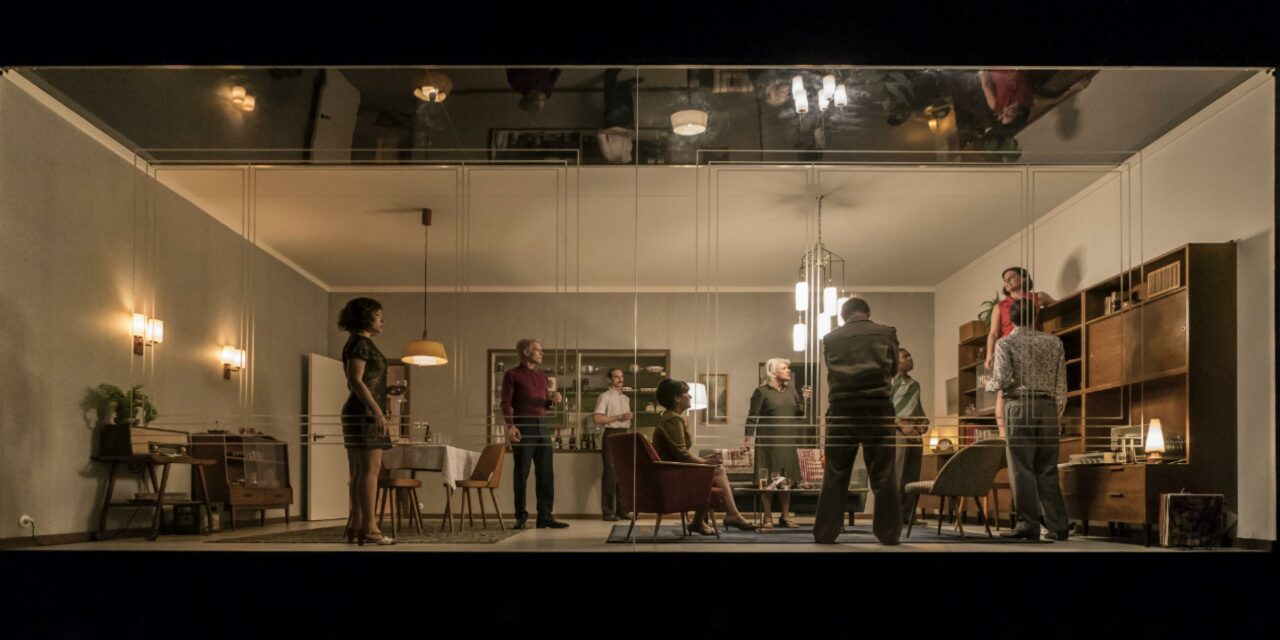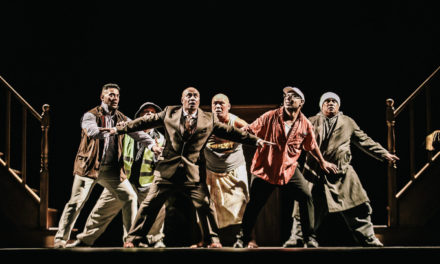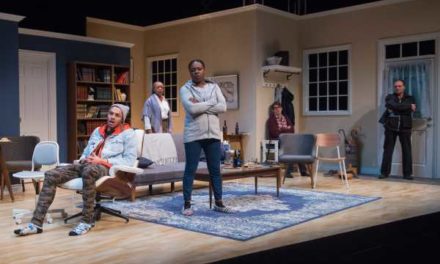Something is tantalizingly amiss at the National’s Dorfman Theatre. There is a headset attached to every seat; the auditorium’s seating capacity is strikingly diminished; and the figurative fourth wall has been made literal—well, glass.
ANNA, Ella Hickson’s ingeniously restrained new play at the National Theatre, is set in an East Berlin flat in 1968. At a time of state-sponsored surveillance and heightened paranoia, the play’s titular character is about to host a party to celebrate her husband’s recent promotion, which is itself triggered by the murky “disappearance” of his former boss. As her guests trickle in and alcohol starts to flow, Anna is thrown off course by the seemingly unexpected appearance of a disturbing figure from her past. Before long, she’s out to sabotage the festive mood and point fingers, raising her voice to the point of dissent. Or so it seems—as nothing within these four walls is safe from suspicion, not even suspicion itself.
In her previous play, The Writer, Hickson had brilliantly asked not only what it means to construct a feminist dramaturgy, but what it would take to stage it in a patriarchal society. In ANNA, she is joined by co-creators and sound designers Ben and Max Ringham in investigating the dramaturgy of surveillance. The scenic result, designed by Vicki Mortimer, is a glass box (or cage) within which the interior of Anna and Hans’s flat is rendered in hypernaturalistic detail. Throughout, Hickson’s characters are trapped in this bell jar of a space, which turns out to be more fortified than it appears, as they are inaudible without the vital aid of an audio headset, worn by every member of the audience for the duration of the show.
There may be a thick glass that separates us from the action on stage, but the aural dimension of ANNA countervails this imposed distance by taking us deep into what transpires behind that glass. Our hearing is sonically focalized through Anna: we hear only what she hears, ranging from the most ghostly whisper to the loudest bang. Even though the entire set is decked with microphones, so as to capture the muffled noises emanating from objects and the cacophony of much of the party, it soon becomes clear that these are meant to be centered on Anna. (For example, when she enters the bedroom and closes the door, the scene in the living room is suddenly muted.) The effect is searingly intimate and disturbingly resonant, all the more so because this is no mere gimmick. Rather, ANNA makes voyeurs of its audience in thematically fitting ways, but not without revealing—in a series of twists both suspenseful and shrewd—who has been in charge all along.
Even as it increasingly blurs the distinction between the surveillant and the surveilled, Hickson’s play does not lose sight of its well-defined but complex concerns. Many a dramatist has grappled with the myriad interminglings of the personal and the political, but only a few could extract so much from that elusive vanishing point with such economy and understatement, and in just an hour. Central to Hickson’s take on this is the question of how far one might be willing—indeed, incentivized—to go to exorcise personal demons of the past by means of repressive political structures. With fleeting echoes of Ariel Dorfman’s Death and the Maiden, Hickson’s plot feels at once nimble and dense, thrilling but not gratuitously so. Unfolding in real time and displaying a predominantly realist tenor, the action perpetuates a revamped slice-of-life aesthetic that rises to great heights. There may be a few moments that seem implausible at first, but hindsight unlocks their inherent, though necessarily clouded, self-consciousness.
The cast deserves much praise for their impressive performances: Phoebe Fox’s credibly shape-shifting Anna thwarts expectations, fuelling the play’s twists with admirable control (and with dints of abandon). As her husband Hans, Paul Bazely captures his character between the opposing impulses of caution and resistance, until the play’s haunting coda allows him to reveal an unforeseen depth. Hans’s new boss Christian Neumann, who, Anna claims, was complicit in her mother’s murder twenty-five years ago, is played by Max Bennett with a glossy surface but a rivetingly evolving interiority. Natalie Abrahami’s direction has a fine sense of spatial dynamics in this restricted playing field, governing the audience’s attention across multiple points with subtle but handsome maneuvers.
ANNA is one of those works where form and content are brought into a remarkably symbiotic relationship. Rather than take for granted its allegiance to immersive realism, the production more than justifies the mechanics of its storytelling. Some might find the story bland, and some overwrought, but it is precisely between these two extremes that ANNA situates itself with mastery: its theatricality—for it has one—is at once smart, sincere, and sleek. It is, all in all, exemplary achievement in the fusion of old forms with new technology.
This post was written by the author in their personal capacity.The opinions expressed in this article are the author’s own and do not reflect the view of The Theatre Times, their staff or collaborators.
This post was written by Mert Dilek.
The views expressed here belong to the author and do not necessarily reflect our views and opinions.


















